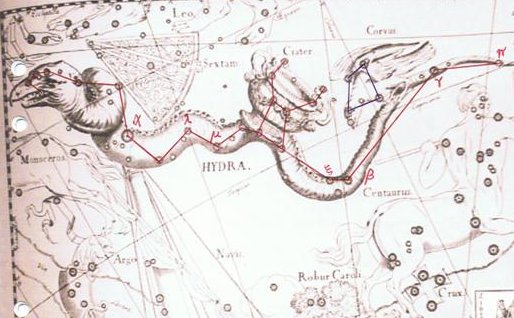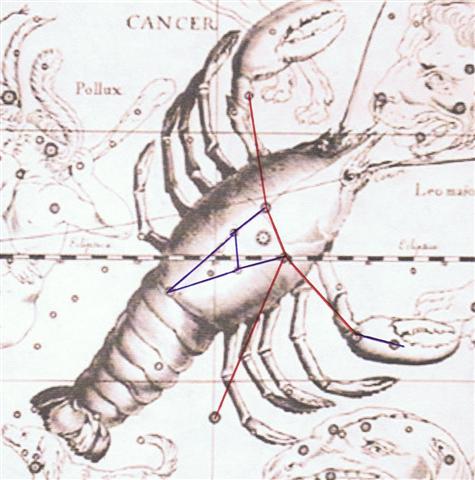10. These are the glyphs for 'August (we have to move on):
 |
 |
 |
 |
| Ka4-7 |
Ka4-8 (70) |
Ka4-9 |
Ka4-10 (*136) |
| |
ζ Hydrae (134.1) |
Acubens, Talitha Borealis (135.0) |
ρ Ursa Majoris (135.6), ν Cancri (136.0), Talitha Australis (136.1) |
| 'August 1 |
' 2 (214) |
'3 |
'4 |
| Alhena 11 (77) |
12 |
13 |
Murzim 1 (80) |
 |
 |
 |
| Ka4-11 (73) |
Ka4-12 |
Ka4-13 |
| ω Hydrae (136.8), σ¹ Ursa Majoris (137.0), κ Cancri (137.3), Alsuhail (137.5) |
σ² Ursa Majoris (137.6), τ Ursa Majoris (137.7), ξ Cancri (137.8) |
Miaplacidus (139.3) |
| '9h (137.0) |
'August 6 |
'7 |
| Murzim 2 (81) |
3 |
4 |
 |
 |
 |
 |
| Ka4-14 (*140) |
Ka4-15 (77) |
Ka4-16 |
Ka5-1 |
| Tureis (139.8) |
|
Al Minhar al Asad (141.6), Alphard (142.3) |
ω Leonis (142.6), τ¹ Hydrae (142.7), Alterf, τ² Hydrae (143.4), ξ Leonis (143.5) |
| 'August 8 |
'9 |
'10 (222) |
'11 |
| Murzim 5 |
6 (85) |
7 |
8 |
 |
 |
 |
 |
| Ka5-2 |
Ka5-3 (81) |
Ka5-4 |
Ka5-5 |
| A Hydrae (144.1) |
Ukdah (145.4), κ Hydrae (145.5) |
Subra (145.8), ψ Leonis (146.4) |
Ras Elaset Australis (146.6) |
| 'August 12 |
'13 (225) |
'14 |
'15 |
| Murzim 9 (88) |
10 |
11 |
12 |
 |
 |
 |
 |
| Ka5-6 |
Ka5-7 |
Ka5-8 (*150) |
Ka5-9 |
| υ¹ Hydrae (148.4) |
Ras Elaset Borealis (148.7) |
ν Leonis (150.1) |
π Leonis (150.6) |
| 'August 16 |
'17 |
'18 (230) |
'19 |
| Murzim13 (92) |
An Nathra 1 |
2 |
3 |
 |
 |
 |
 |
| Ka5-10 |
Ka5-11 |
Ka5-12 |
Ka5-13 |
| υ² Hydrae (151.8), Al Jabhah (152.4) |
Regulus (152.7), λ Hydrae (153.2) |
|
Adhafera, Tania Borealis (154.7), Algieba (155.5) |
| '10h (152.2) |
'August 21 |
'22 |
'23 |
| An Nathra 4 |
5 |
6 |
7 |
 |
 |
 |
 |
| Ka5-14 |
Kb1-1 (*157) |
Kb1-2 |
Kb1-3 |
| Tania Australis (156.0) |
μ Hydrae (157.1) |
|
Shir (158.9) |
| 'August 24 (236) |
'25 |
'26 |
'27 |
| An Nathra 8 |
9 |
10 |
11 |
 |
 |
 |
 |
| Kb1-4 |
Kb1-5 |
Kb1-6 |
Kb1-7 (99) |
| φ Hydrae (160.3) |
|
|
ν Hydrae (163.1) |
| 'August 28 |
'29 |
'30 (242) |
'31 |
| An Nathra 12 |
13 |
Alterf 1 |
2 (107) |
The rising fish manu kake (Kb1-7) presumably means some kind of light is about to return (because the internal 'star pillar' has right side up and the front part of the fish tail is slightly uplifted). There seems to be a dark time beyond the descending kahi in position 46:
 |
 |
 |
 |
48 |
 |
 |
| Ka3-5 |
Ka3-6 |
Ka3-7 |
Ka3-8 |
Kb1-6 |
Kb1-7 (99) |
| Wasat (109.8), Mekbuda (110.5) |
Aludra, Propus (111.1) |
Gomeisa (111.6), ρ Gemini (112.1), τ Gemini (112.3) |
Castor (113.4) |
|
|
ν Hydrae (163.1) |
| 'July 9 |
'10 |
'11 (192) |
'12 |
48 |
'30 |
'August 31 (243) |
| Heka 1 |
2 |
3 (56) |
4 |
Alterf 1 |
2 (107) |
243 = 3 * 3 * 3 * 3 * 3 and 107 = 472 - 365. 243 = 193 + 50.
The middle glyph in this dark time is number 72 at ν Cancri, 136 days beyond 'March 21 and 80 days counted from Sheratan 1. This is where the Sirius (Murzim) manzil is beginning.
"Nu ... is the 13th letter of the Greek alphabet. In the system of Greek numerals it has a value of 50. It is derived from the Phoenician letter nun

Nun is thought to have come from a pictogram of a snake (the Hebrew word for snake, nachash begins with a nun and snake in Aramaic is nun) or eel.
Some have hypothesized a hieroglyph of a fish in water for its origin (in Arabic, nūn means large fish or whale). The Phoenician letter was named nūn 'fish', but the glyph has been suggested to descend from a hypothetical Proto-Canaanite nahš 'snake', based on the name in Ethiopic, ultimately from a hieroglyph representing a snake

Nahš in modern Arabic literally means 'bad luck'. The cognate letter in Ge'ez and descended Semitic languages of Ethiopia is nehas, which also means 'brass'." (Wikipedia)
Possibly ν Cancri was at the 'midday zenith' in the sky map: 
In Egypt the direction up is in south and the 'black serpent' has a position high up. In Polynesia southwest was the direction of winter (toga). Perhaps there is an empty wooden platform for the dead Sun below the serpent.
| Toga 1. Winter season. Two seasons used to be distinguished in ancient times: hora, summer, and toga, winter. 2. To lean against somehing; to hold something fast; support, post supporting the roof. 3. To throw something with a sudden movement. 4. To feed oneself, to eat enough; e-toga koe ana oho ki te aga, eat well first when you go to work. Vanaga.
1. Winter. P Pau., Mgv.: toga, south. Mq.: tuatoka, east wind. Ta.: toa, south. 2. Column, prop; togatoga, prop, stay. Togariki, northeast wind. Churchill.
Wooden platform for a dead chief: ka tuu i te toga (Bb8-42), when the wooden platform has been erected. Barthel 2.
The expressions Tonga, Kona, Toa (Sam., Haw., Tah.), to indicate the quarter of an island or of the wind, between the south and west, and Tokelau, Toerau, Koolau (Sam., Haw., Tah.), to indicate the opposite directions from north to east - expressions universal throughout Polynesia, and but little modified by subsequent local circumstances - point strongly to a former habitat in lands where the regular monsoons prevailed. Etymologically 'Tonga', 'Kona', contracted from 'To-anga' or 'Ko-ana', signifies 'the setting', seil. of the sun. 'Toke-lau', of which the other forms are merely dialectical variations, signifies 'the cold, chilly sea'. Fornander. |
The nun eel-serpent presumably refers to the Hydra constellation and the creator of the K text could have known this. 
The position of ν Hydrae is where Crater is beginning and at manu kake in 'August 31. The distance from ν Cancri is 27 (= 3 * 3 * 3) days:
 |
26 |
 |
| Ka4-10 (72) |
Kb1-7 (99) |
| ρ Ursa Majoris (135.6), ν Cancri (136.0), Talitha Australis (136.1) |
|
ν Hydrae (163.1) |
| 'August 4 (216) |
26 |
'August 31 (243) |
| Murzim 1 (80) |
Alterf 2 (107) |
Gregorian day 216 marks the position at 3 / 5 of a 360 day cycle. 3 * 72 = 216.

The top eye of Cancer is (according to Hevelius) the position of ν.
From Castor to ν Hydrae there are 50 days (the number value for nu):
 |
49 |
 |
| Ka3-8 (49) |
Kb1-7 (99) |
| Castor (113.4) |
|
ν Hydrae (163.1) |
| 'July 12 (193) |
49 |
'August 31 (243) |
| Heka 4 (57) |
Alterf 2 (107) |
|






























